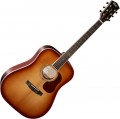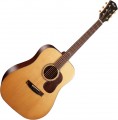Bottom deck
The material from which the lower soundboard of the guitar is made is a flat surface on the opposite side from the upper soundboard (it is this surface that is adjacent to the musician's body when the instrument is held normally).
The value of this parameter is described in detail in the “Upper deck” section — what is stated there is also true in this case. We only note that a wider range of materials is used for the lower deck: this part is less demanding on the characteristics of the material, which gives manufacturers additional choice.
In terms of specific materials,
rosewood,
sapele,
maple,
meranti and
nato, among others, enjoy considerable popularity in modern times. Here is a brief description of each of them:
— Rosewood. A name that combines the wood of several species of tropical trees. This material is said to provide deep sound and enhance bass quality, thereby improving the guitar's efficiency when playing rhythm parts on chords.
— Sapele. Also known as "African mahogany" due to its characteristic hue. It contributes to an even sound with medium depth and good expression of individual notes, which is considered important especially in solo parts.
— Maple. Maple wood is prone to a rather sharp and sonorous sound without much depth. However, this is
...not a drawback, but a feature: for some styles of music, just such a coloring of the sound is perfect.
— Meranti. Wood of trees of the genus Shorey, growing in the tropical forests of Southeast Asia. This material is mainly used in instruments manufactured by Yamaha, mainly classical guitars and ukuleles — it is for these varieties that meranti is considered the best option.
— Nato. A relatively inexpensive variety of mahogany (mahogany) used in guitars in the corresponding price range. Contributes to a dense, but not very bright sound.Shell
The material from which the side of the guitar is made is the “side” surface of the body, which unites the upper and lower soundboards (see above).
About the meaning of the material of the body, see paragraph "Top deck" — everything stated in it is also true for the shell. Unless the range of materials used for this part is noticeably wider; also note that most often the material of the shell coincides with the material of the bottom deck. Here is a summary of some of the more popular options:
— Rosewood. A name that combines the wood of several species of tropical trees. This material is said to provide deep sound and enhance bass quality, thereby improving the guitar's efficiency when playing rhythm parts on chords.
— Sapele. Also known as "African mahogany" due to its characteristic hue. It contributes to an even sound with medium depth and good expression of individual notes, which is considered important especially in solo parts.
— Maple. Maple wood is prone to a rather sharp and sonorous sound without much depth. However, this is not a drawback, but a feature: for some styles of music, just such a coloring of the sound is perfect.
— Meranti. Wood of trees of the genus Shorey, growing in the tropical forests of Southeast Asia. This material is mainly used in instruments manufactured by Yamaha, mainly classical guitars and ukuleles — it is for these varieties that meranti is considered the best option.
— Nato.... A relatively inexpensive variety of mahogany (mahogany) used in guitars in the corresponding price range. Contributes to a dense, but not very bright sound.
Bridge
The material from which the bridge (string holder) of the guitar is made is a device with which the strings are attached to the top deck.
Theoretically, the colour of the sound of an instrument depends on the characteristics of all its details. However, in the case of the bridge, this influence is so insignificant that the data on the material in this case are more of general reference and advertising than of real practical value. The variety of such materials is quite large; among the most common are
rosewood,
mongoy and
ebony.
Case
The presence of a
case or cover in the tool delivery kit (what exactly is included in the kit must be specified in each case separately).
A case is called a case made of hard materials, a case is made of soft materials, this is the main difference between these types of accessories. Otherwise, they are similar: both the case and the cover are provided primarily for the convenience of transporting the tool. To do this, the design provides for handles, shoulder straps and other devices that facilitate carrying, as well as compartments for additional accessories (replaceable strings, tuners, etc.). However, it is desirable to store the tool in a case or case — to protect it from dust and other adverse factors.
The “native” case/case is good because it optimally fits a specific guitar model and is immediately sold with it, saving the owner from unnecessary searches. On the other hand, manufacturers often include the simplest types of cases in the kit, with minimal additional features and a very limited degree of protection. This is especially true for cases that can be made of thin material and are only suitable for short-distance movements in warm weather without rain. Therefore, sometimes it makes more sense to buy a case separately.

